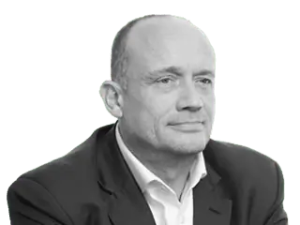
13min read
A conversation with Paolo Scalco

A blueprint for the Family Office
Paolo Scalco, Family Office Advisor
We hear from Paolo Scalco, an experienced Family Office Advisor who shares with us some of his thoughts and observations of working in the family office and family business world.
Paolo Scalco has a plan; a blueprint for a successful family office that goes beyond a simple checklist for setting-up an office or a periodic review. Encompassing more than just technical and functional criteria, it engages emotional intelligence and strategic thinking to support the on-going evolution of your family office.
Paolo’s curiosity about the entrepreneurial process has led him into roles with a family-established venture fund, a multi-family family office and a single family office, across a variety of industries and different countries starting out from Johannesburg, in his native South Africa. Here, he shares some of his thoughts and observations of working in the family office and family business world.
According to Paolo, the decision to set-up a family office usually happens when a family and/or the family’s operating business hits a crux point. The nature of the resulting transition will be different depending on the family.
What is a transition?
Often, people in the family business world talk about a liquidity event when considering family offices, when it’s more helpful to talk about transition.
Is re-aligning a family office more challenging than just setting one up?
When you start with a blank piece of paper, you can sit down and plan what you want and why you want it – it’s easier. Trying to re-align a family office comes with challenges because it comes with a culture, history, and context. It has a legacy, both in terms of systems and people: the way you worked, who you worked with and for, and there may be vested interests in why the family office was created in the first place. Trying to do a re-alignment in your family office is harder.
Where to start?
“Understanding your situation is really important, therefore a situational analysis is critical. What I mean by this is, treat your family office as a business; is the situation that of a start-up, realignment or sustaining a well-functioning entity,” suggests Paolo. “The obvious first question – and it is a cliché – is to ask ‘why?’. What is the purpose of the family office? What do you want it to do? What is it’s objective – what are the goals that it needs to achieve? And then everything flows from there.
I think a subtlety that most people don’t think about is to also think about ‘who’? Who is starting the family office? Because, ‘who?’ very much connects to ‘why?’. You need to understand what ‘who?’ may mean in terms of your transition in the future – a number of years down the line – because the office will be embued with the founding matriarch’s or patriarchs’ personality, thoughts and views. I think that for the family, ‘why?’ is very important and then for the set of advisers that the family assembles to help them, ‘who?’ – understanding the individual and their objectives and what that may mean for the family longer term is a question they should also be asking.
According to Paolo, ‘who?’ can cut multiple ways. One way is who you’re going to get to run your family office – what technical and functional skills do they bring to the table? Another way is who will the family office serve, whether it is an embedded private office within the operating entity, a founder-led family office, a family-first office, or a family enterprise office, you need to understand what ‘who?’ means in terms of what they inject into the mix and the system, because you’re going to have a system.
Whoever may be running your family office – whatever format that initially takes, or evolves into; who is the main interacting stakeholder(s) – or however the family structures that, be it a shareholder advisory council, or family council that’s interacting with the family office; and then the broader family as your clients and your stakeholders, which will include the next generation, or multiple generations – you’ve got a family office system. So the ‘who?’ cuts multiple ways in terms of understanding how that system looks and what that means, before getting to the hard skills bit around who’s the right person to run the office.
Are existing trusted advisers the best choice?
Paolo believes that the right person to run the family office needs more than just the right technical and functional skills, “I think you really also need strategic skills,” he says. “You need to ask yourself, does this person have the strategic nous to understand the vision and the journey? To help me set-up now, but also to see what it will look like in five or ten years’ time? The context of the system?
What about cultural fit?
This is the most important question, in Paolo’s opinion. “Are they going to fit with the family? Do they have our values and is there value alignment? That kind of gets you to the point of trust,” he says. “An existing trusted individual has had time to build-up credibility: you know their capabilities and I think that is incredibly important – that would be my starting point,” he adds. “But taking it a layer back, the question you’re really asking yourself is: ‘Is there the right cultural and value fit and alignment?’ That’s the fundamental first question to ask as a family, because that’s the basis from which you build trust.
If you have that already in your existing organisation, that’s a great place to start! Then you can layer on the other aspects. If the person then has strategic thinking abilities as well as the functional and technical skills, well then you know what? You’ve hit the jackpot and your life has just got a lot easier!
What happens next?
“I frame it in the following way, I’ve termed it the three Es and the seven Cs,” proposes Paolo. “It’s an approach for a process. We’ve answered the ‘why?’ and we’ve touched on the ‘who?’ and that kind of leads us into the three Es which are: Empathy, Engagement and Evaluation,” he explains.
“These are really critical to better understanding some of the why: the emotional importance of setting up the family office and what you want to achieve from it. To gently tease out some of those intangibles; all those really important emotional aspects. You really get a good feel for value and culture through that.
According to Paolo, that discovery process will depend on where the family is in its journey and the complexity of the family structure: “It could be a very quick conversation or it could be more in-depth depending on the circumstances, and the dynamics,” he explains.
That then leads into the seven Cs: “You’ve got the context, you understand the challenge – you’re starting to shape clarity in terms of what you want, why you want it, the who and the how, and that starts leading into your configuration and co-ordination,” he elucidates. “What are the services and functions and how will you configure that? Will it be in-house or outsourced? What will be the other service providers? What’s going to be in the inner-circle, the secondary circle and the third circle that is wrapped around the family, and what does all that mean from a co-ordination perspective, or in terms of resource strains internally? The final Cs are around communicating with the primary family stakeholders and the broader family office clients and systems.”
Does the same process work for office realignment?
“We’ve all heard the cliché: ‘If you’ve seen one family office, you’ve seen one family office’. Dennis Jaffe offers a really valuable insight, he says that “if you’ve seen one family office then you’ve seen one family office at a specific point in its evolution”. For me, that is the missing component – it’s an “evolution,” Paolo shares. “For a well-functioning family office to have success, it needs to be cognizant of where it is in terms of its point in time and the stage it is at,” he explains. “Then, as the adviser, you can look at the technical and functional skills required and ensure the relationship bonds are appropriate for that point in time.
“I think you can apply the three Es and the seven Cs to a re-alignment. You start again with a situational analysis, in terms of where are you on this journey. Is the family office adapting because of a transition? Is it maturing, or is it at the point of a regeneration? Framing those questions slightly differently, you could ask: is it a start-up? Is it going through a growth, or maturing period, or is the family office a turnaround? If it’s a turnaround is that because there are major issues because of external circumstances, or is it just a re-alignment i.e., you’re not in a bad place, but there are a few things off such as, the incentive structure, or the view of where the family should be. Maybe you’ve got a really well-functioning family office and want to sustain that success,” he suggests.
When to review the three Es and the seven Cs
Paolo identifies three occasions: “The first is when you see a transition coming, the second is when you feel friction in the system – when you’re getting signals from the system that there may be a misalignment, or that all the elements aren’t working well together; and then thirdly, you should set yourself a schedule to do a health check to ensure that you’ve got everything in good order,” he outlines.
“There’s a high level of emotional intelligence that needs to be applied to the three Es to pick up on that sense of friction,” he comments. “It highlights the importance of having someone who understands the culture to pick-up on these sorts of things,” he adds. “I also think it’s incumbent upon whoever is operating the family office space, as a best practice, to set themselves the task, say every three years, to run through a review.”
Marking your own homework?
“I think you can do an internal check, but that requires a degree of honesty,” says Paolo. “That’s a conversation between the family office team and the family members. There’s a level of trust and maturity that needs to be in place in order to have that discussion. Then it’s really helpful to turn to trusted external advisers, just to run through for a health check.”
What does good look like?
It all comes back to the initial question: ‘why?’. What are you setting the family office up for? What do you want to achieve from the family office? “From that main objective you start setting up the metrics, in terms of what ‘good’ looks like and then build out.” He gives an example: “If you wanted a very direct investment-led family office, you would look for a particular profile of individual, you’d incentivise them in a very particular way, and you’d monitor their performance accordingly. So, it really comes back to the objective, then you can say what good looks like, set out how to measure good, and then tie that down into the running of the family office in terms of KPI’s and structures,” he explains.
Can technology help?
Paolo thinks so: “There’s a lot of great technology and I think you should try to lead with it as much as you possibly can in terms of getting engagement, support, and understanding about why you have the family office. It ties in to how you communicate,” he points out. “If you can leverage technology then that’s fantastic, but I’ve also seen lots of efforts going into using technology which is just not adopted. You need to make sure that if you are adopting technology, it’s really easy, very low friction to adopt, and not something extra that’s going to clutter-up your iPhone,” he advises.
The three most important things to get right:
- Make sure you’ve got the ‘why?’.
- Ensure you have a good grip on your situational analysis and the specific point in your family office’s evolution.
- Make sure that the key relationship nodes, or inter-relationships, will all work well
Three things to avoid:
- This is a personal bias, but I think sometimes families dive-in too quickly and just look for the technical and functional skills that they want or require. You need to make sure you have the culture and value fit because that’s going to give you the basis of trust, and also find someone with vision and strategic thinking capabilities.
- Be patient. Accept that it will take time. There will be a lot of dynamics and emotions that you’ll have to work through. Don’t rush it. Build in more time than you think you may need.
- Recognise that there is going to be evolution. Your family office will and needs to change, if it’s going to regenerate. If you’re starting to build a family office that you want to be multi-generational, you have that mindset built-in from the outset. Build for today but understand that at some point in time, that will change and that’s OK. What’s fit for purpose today may not be fit for purpose in a couple of years’ time.















